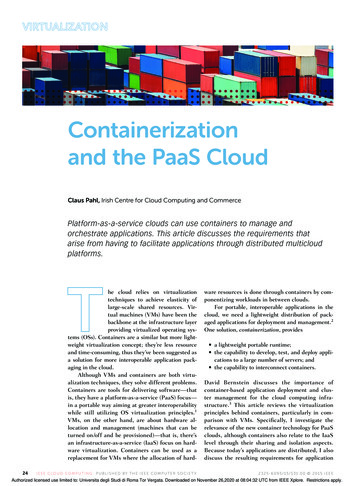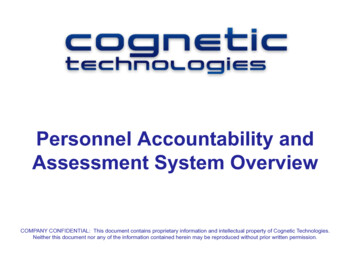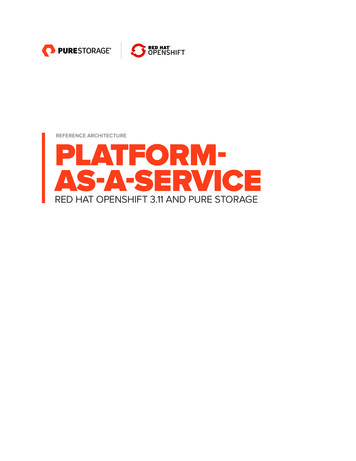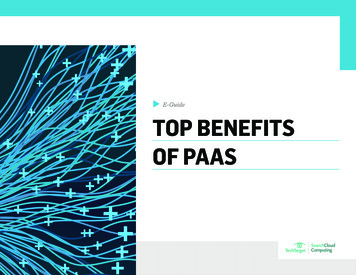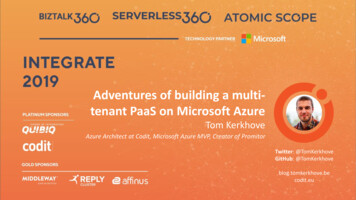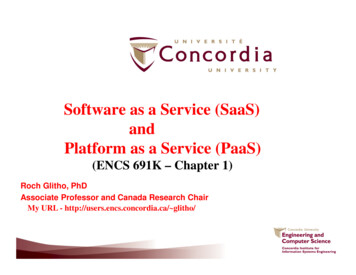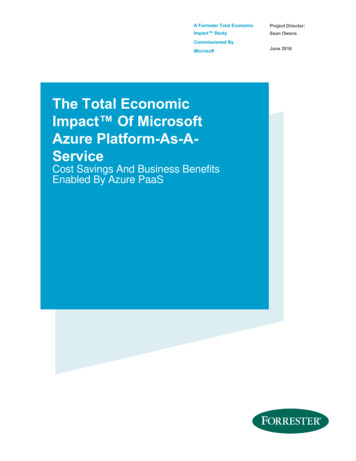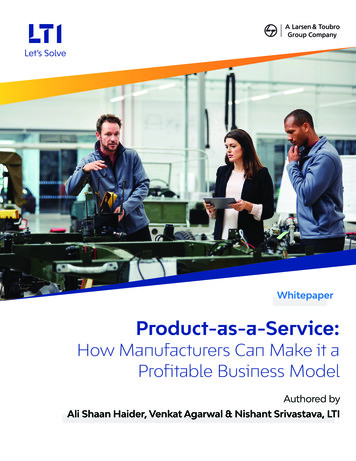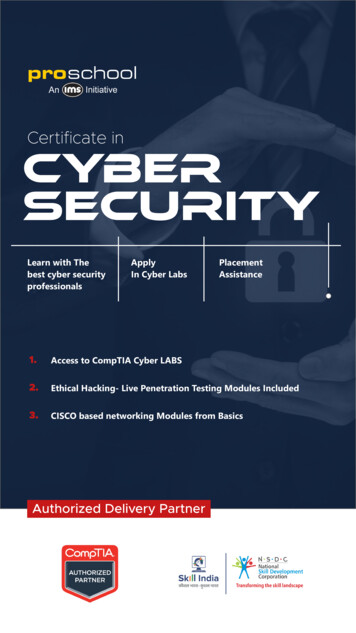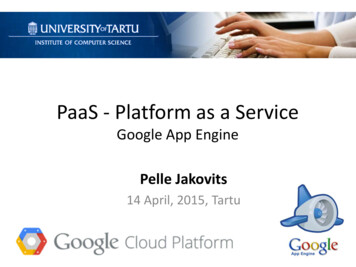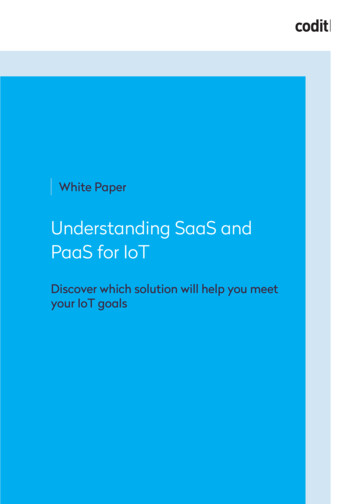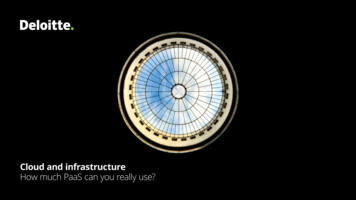
Transcription
Cloud and infrastructureHow much PaaS can you really use?
About the seriesContentsAbout the seriesBackgroundOverview of PaaS2Considerations for PaaS3Show me the money5There are still rules and risks6People and operating model6Conclusion7OverviewIn order to enable new business and preserveexisting value, global Information Technology (IT)executives should address the growing dichotomybetween the agility companies want, and thestability they need. This dichotomy is becomingexacerbated as legacy data centers become fartherand farther removed from the cloud and frommobile end users. Meanwhile, delivering data todevices and taking advantage of platforms oftenmeans giving up some control over operatingsystems, hardware, and data centers. It’s 9 a.m. onMonday. Do you know where your data is?IntroductionAs IT executives look to provide value from their ITportfolios, they are balancing a mix of emerging,current, and legacy technologies. With the world oftechnology ever evolving at pace, the gulf betweenemerging and legacy continues to widen. Theconsumer market drives advances in end userdevices and end user expectations. Service vendorsinvest in cloud, virtualization, and orchestration,while manufacturers attempt to deliver morecompute horsepower at lower cost. Behind thetablets, clouds, and chips, there still sits a datacenter and a room full of legacy infrastructurewaiting for refresh.This widening gap between end user devices, datamobility, cloud services, and back office legacysystems can challenge the IT executive to manageand maintain technology in a complex array ofdelivery capabilities. From mobile apps to mainframeMIPS, and from in-house servers to sourced vendorservices, managing this broad range requires a viewon how much can change by when, an appropriateoperating model, and a balanced perspective onwhat should be developed and controlled, and whatneeds to be monitored and governed.To help equip the IT executive in forming thoseviews and making those judgements we presentpoints of view on key trends and topics.BackgroundMany IT executives are always on the lookout forways to standardize software and IT infrastructure,and to simplify development, support, andmaintenance processes. At the same time theyconsider where there may be competitive advantage,and how best to balance the emerging, current, andaged technologies available. This is particularly truewith the recent growth of areas such as analytics,mobility and social media, and the Internet of Things,which could each be addressed via platform services.Maturing “platforms” are rising above the hypervisor,providing enhanced automation and developerself-service, programming interfaces, and moreintegrated middleware and management capabilities.These emerging services abstract applications frominfrastructure, eliminate the need to buy, host, andoperate compute and storage, and offer the potentialto simplify and standardize in one go.But it’s unlikely that a cloud platform-as-a-service isthe best answer for all use cases, or even whether1
an organization wants too many apps in one basket.Even if you want to, your current applications mightneed significant rework in order to be cloud andplatform ready.So you’re potentially left with a mixed bag of cloud,internally optimized, and legacy capabilities—eachrequiring a different management approach.The Past: Technology StacksIn the past, enterprise Chief Information Officers(CIOs) and Chief Technology Officers (CTOs) largelybuilt and owned their technology stack. They wouldbuy or develop business application software thatutilized a given IT infrastructure. And they wouldbuy, support, and manage that IT infrastructure.Their operating model would enable applicationsoftware to be designed, deployed, maintained, andrefreshed using a specific stack. And they woulddeploy, maintain, and refresh that infrastructurethemselves. However managing this breadth anddepth of the supply chain and its complexity couldhinder growth and innovation in an organization.The Present: IaaS ModelToday, sourcing and governing an Infrastructureas-a-Service (IaaS) is more common. An integratedIT infrastructure stack is procured, based on a setof standards, and is presented to consumers withsome level of automated provisioning, likely withsome virtualization and a utility consumption model.This might be provided on or off premise, and ina private or public service. Public cloud IaaS nowenables organizations and individuals to leveragecomputing power without the need to worry aboutbuying or housing IT infrastructure. In an IaaS model,application development is still oriented to takeadvantage of a specified infrastructure and thereis likely still a need to configure and deploy thebusiness software and infrastructure layer to workwith each other.The Near Future: PaaSA much hyped but still maturing service is Platform asa Service (PaaS). A “platform” in this sense builds onthe IaaS model by providing not only the compute andOS layers, but the server and runtime managementand additional automation and orchestration.These provide application software developers withthe means to deploy and manage their softwarethemselves with application relevant service levels andcharacteristics. By having the middleware, operatingsystem, and hardware abstracted from the applicationsoftware, the organization needs less infrastructureoperations, and the application developer spendsless time deploying and provisioning, and more timedeveloping valuable software.PaaS adoption statsThe PaaS market is estimated to reach 7bnby 2018 implying a 5 year CAGR of almost23 percent1Overview of PaaSMarket driversMany organizations today are creating a generationof custom applications that are leveraging thepotential of cloud capabilities. They often attemptto deal with the pressures of creating greatbusiness value by providing increased flexibility andspeed, while managing greater uncertainty. Theyuse approaches to validate, learn, and pilot newcapabilities, while balancing risk in new developmentso they may fail fast, learn from the effort, and moveon. All the while, they are dealing with unpredictablerequirements and capacity needs.TrendsIn response, SaaS and IaaS providers alike are movinginto PaaS to help provide enterprise customers theagility and flexibility they require. For example, AWSand Azure are evolving from IaaS with value addedpoint solutions to a turnkey PaaS offering which is stillemerging. Many organizations are trending towardsturn-key private PaaS offerings (e.g. Pivotal CloudFoundry, Apprenda). While the market and productsare still maturing many firms wait for the winners toemerge. The market is evolving quickly and we expectsignificant growth in the coming 2–3 years (15–30percent growth by category).Service offeringLike other cloud services, a PaaS can be providedon or off premise, and in a private or public manner.Differing delivery models offer variety in terms ofagility and control—where public hosted or managedcan provide greater agility, private hosted ormanaged provides more control.2
A PaaS provider may offer abstraction and sharedservices via a container-based approach, ahypervisor and virtual machines, or both. There isdebate about full machine virtualization, or OS levelvirtualization provided by containers. But as muchfocus as there is now on containers, from Docker tocluster managers like Kubernetes, there is a place forboth. Google for example runs all of their servicesin containers, and that includes their VMs2. Serviceproviders are likely to provide both capabilities.But by now the IT executive might be less interestedin the mechanics of how a PaaS provider managestheir underlying compute layer and more interestedin the features, characteristics, and price points ofthe service.PaaS options should be considered for the level andrichness of the abstraction and automation layer. Afew questions in your checkbox could be:What limitations or requirements are there in terms of deploying an application?Can a developer or other appropriate staff truly “click and deploy” software?Are the service levels clear and unambiguous?Are there straightforward but appropriate options in terms of availability, latency,response time, user concurrence, RPO & RTO?Are there controls over data encryption, key management, and data at rest and in transit?Are patches, upgrades, or refresh to the middleware, operating system, and hardwaretransparent or self-service?Do you need anyone at all to support or maintain anything beneath the application layer?Considerations for PaaSEnterprise valueAn enterprise value-driven approach is an option toenable PaaS adoption within the IT service operatingmodel. Understand industry trends, their impacton the organization, and how they could impactthe operating model. Look to articulate businessand organization objectives and goals that willdrive positive transformation, and then develop abusiness case and benefits tracking mechanism tovalidate benefit realization. Develop a value-drivenenterprise capability architecture. These stepsenable the organization to look at any PaaS potentialbeing informed by critical business capabilities, andto understand any opportunity to rationalize theapplications portfolio aligned to those capabilities.PaaS solutions can then be selected based on theexpected benefits vs your overall management of risk.Feature maturityTo realize PaaS’s full potential, consumersshould determine if the service itself is fit forits intended purpose.It can be useful to have differentiated service levelsand price points that can be used for applicationworkloads of differing criticalities and servicewindows. Variability in performance and disasterrecovery characteristics, dev/test vs. production,and the associated unit price points ensures abroader spectrum of candidate applications andincreased cost variability: How mature are the service providers, commercialmodels, features, and functions? What technologies are being used within theservice, what is one’s view on their quality andfeatures, and do these align with one’s needs? Are there any proprietary components orfeatures that could lock one in or make movingworkloads difficult? Are the services standardized across the PaaSoffering? Is the PaaS offering portable between vendors?Understanding the gapPaaS services include items like development tools,middleware, a runtime environment, and self-serviceoptions. But there may be entry requirements tosatisfy if your workloads are to operate in the PaaS.Application interfaces, support and maintenanceapproaches, and data management aspects couldbe defined in a PaaS standard. Understand thatthe approaches, tools, languages, and technologiesare things that can be used, are appropriate, anddon’t create unnecessary vendor and/or proprietarytechnology lock-ins. And of course, consider thefuture development and application needs to meetthe rapidly evolving demands on the business.A gap analysis will be required to take these itemsinto account and compare the enterprise withthe supplier in terms of technology roadmap, andapplication, data, and security architectures.3
Key PaaS FiguresThinking beyond strategic IT“More and more business leaders are recognizingits [the cloud’s] profound implications for howenterprises can make money, differentiate, andcompete. Business leaders of all stripes—Finance,Sales & Marketing, Product Development andmore—are becoming increasingly focused onthe business value cloud provides. Over thenext three years, cloud’s strategic importanceto business users is expected to double from 34percent to 72 percent, even surpassing their ITcounterparts at 58 percent.” 3Trends in the suppliersTrends in the Industry Application PaaS holds the highest segmentof PaaS market share (35 percent) followed byADLM PaaS (16.3 percent) Mature markets such as Western Europe, U.S.and Japan are leading the PaaS adoption Vendor innovation and demands of the userare driving the availability of leading edgecapabilities in PaaS which is its advantage oversoftware on-premises Private PaaS is seeing the highest adoptionrates 4Trends in buyers The PaaS Market is a highly fragmented andcrowded market, however over 50% of thevendors are niche players with only a fewdozen clientsCIOs primarily buy cloud services for an increasein business agility and speed of business. Thefollowing were cited as the primary reason topurchase cloud: Almost 73 percent of the firms are clients ofthe top 5 providers and about 53 percent areclients of the top 2 Scalability & Agility: 50 percent The fast growth rate of the PaaS industry andits strategic relevance to IT is what is attractinginvestments from both new players as well asestablished vendors 5 Cost Reduction: 14 percent Innovation: 13 percent Quality & Reliability: 10 percent Other: 7 percent Financial considerations: 5 percent 6Based on the gap analysis, understand what changesmay be needed that enable existing applications tomigrate and run on PaaS. This could be anythingfrom programming language and SDK support, todata architectures and APIs. Estimate the effort andtime needed to make those changes and the effortto migrate and manage the process.And look for improvement opportunities from thegaps. If a target PaaS provides easier provisioning,have a plan to optimise the need for those skills andprocesses accordingly.Technology service providers generally requirecustomers to maintain currency with supported andmaintained releases. Where are the PaaS providersgoing with their particular technology and releaseroadmap? Understand what will be needed to keep up,or what could change over time in order to maintainsoftware currency with changing PaaS standards.Dealing with another roadmapAlong that same vein, the CIO will likely be usedto laying out a technology roadmap, not being aconsumer of someone else’s. A public or hybridPaaS model challenges the CIO to select theavailable vendor architectures and engineeringstandards as opposed to defining or developingthem in-house. And it changes the model in whichyou sustain compliance with vendor services overtime. The semblance of control over architectingand engineering the middleware and OS/hardwarestack decreases, and by definition the infrastructureoperations is outsourced.In the event an organization has a mixed portfolioof PaaS, IaaS, and in-house or legacy technology,its operating model will need to cater for all thoselifecycles. A firm will likely need to apply varyinglevels of architecture and engineering standards todifferent things. And it can require a combination ofpeople that develop for the PaaS services and selfservice their workloads, and for retained servicesthat can manage the full support cycle (develop,deploy, provision, support, maintain, and changeapplications and IT infrastructure).These aspects again highlight the need to look atiterative approaches (validate, learn and pilot) and tomitigate risks in learning to fail fast, frequently, andsmall. Your own roadmap could be based on an agileapproach, given that a more standard SDLC may notsucceed in adopting nascent PaaS models.Consider diversificationBe flexible and dynamic with your choice of serviceproviders. Have a target ratio of services to putinto PaaS, and with a single provider. Depending onsize, geographic spread and corporate risk profile,understand if a single or multi-vendor approachis more appropriate. Ensure that applications arefungible between platforms and understand howworkloads can be moved between providers or tofuture providers.4
Public cloud services spending forecast (Gartner, 2015) 7Billions of dollars 350 300 250 200 150 131 154 175 203 237 274 312 100 50 0201320142015Existing portfolio mixLooking at PaaS, the IT executives should considerwhat balance their IT portfolio should have. Do youget competitive advantage from the applicationfunctionality, from the technical ability of the ITinfrastructure layer, or both together? There may bethings that should be highly bespoke and customized,some other things that leverage common elements ortechnologies, and things that are highly standardizedusing commodity technologies.While there may be a real advantage and businesscase to having bespoke applications on specifictechnology stacks, these may not be appropriatefor a public/shared off premise PaaS model. Forexample, specialized low-latency workloads and/orthose that use specific hardware devices. In additionthere may be parts of the landscape that are onlegacy technology not readily transferable to a PaaSmodel—needing too much time and money to worryabout a PaaS target state before some intermediaterefresh step.2016201720182019Applications on wintel x86 architectures,perhaps already using virtualization, crossplatform applications already on web and/orJava technology, and those with a stateless dataapproach are the more obvious parts of thelandscape to be early PaaS migrators.For those things that may not be PaaS targets,you’ll consider some other choices to make themost of your IT infrastructure—for exampledriving up CPU utilization, thin provisioningyour storage, or using Virtual Machines orSolaris Zones.And while it would be nice to think that all yourworkloads could be serviced in a one-server-tomany-app ratio, the likelihood is that you still havesome larger workloads where the ratio is invertedto one app to many servers. So virtualization is notthe panacea for all things, as compute grids andstandalone high performance servers do have theirplace. A sample framework to consider is as below,where you map out your infrastructure to the belowmatrix and take the necessary action.The forward planning analysis will be “whatadvantages can one get from PaaS, and what is theratio of things one can get in a given timeframe?”Show me the moneyA simple PaaS equation for your business case is:[(Benefits of PaaS/Proportion of estate that can geton PaaS) (Cost of entry to PaaS Cost of exit ofexisting/legacy Cost of ongoing maintenance)]To sort out the more detailed financial calculations,the finance team will need to understand: the ratio of applications to put into PaaS the potential benefits of optimising the applicationdevelopment and infrastructure operations costs the mix of prices and services being targeted the effort and time needed to change and migrate the ongoing cost of that portfolio mix over timeBusinesscritical/high revenuegenerating the book value, depreciation schedule, andexit strategy regarding assets that may no longerbe requiredA cost and spend optimization approach can be toalign the migration of applications off of assets at thepoint in time those assets fully S budget shareUS CIOs expect their external IT budgets toincrease to 4.8 percent and European CIOsexpect a growth to 3.7 percent in 2014.Cloud and data analysis projects expectedto get the maximum share of the budget. 85
Traditional IT models own IT infrastructure assetsand licenses and use them over time. Whether ornot an asset is being used 24 hours a day does notaffect the capital spent or its depreciation schedule.PaaS service models may offer pricing based onresource units consumed over time. Understand theresource units and how they are defined, measured,and priced.There may be different service levels with differentprice points. Have a target for how much of theenvironment should be in which different service tier.There may be discount tiers for volume consumption,or financial floors or ceilings as commitments. Havea control and governance regime over who, how, andwhen they can request any new items. And be sureto model the number and frequency of changes toapplications that may attract charges.Many service providers use a number of strategiesto differentiate themselves, and to attract andmaintain clients. Understanding the providerbusiness model helps the CIO to be aware ofmotivations and things to consider. The providermay use proprietary technology that could be anadvantage, or a hindrance when you want to movesomewhere else. They may require you to keep onlyon current or n-1 versions, necessitating a regularrefresh cycle that could cost. And they might beplanning on chargeable changes and growth in unitconsumption—betting that you change and addmore than you might expect.There are still rules and risksIf your business operates internationally, thenyou are likely subject to a mix of different policies,rules, and regulations from different jurisdictions.Information security and personal data protectionwill be particular focus areas, and you may also findlegal, compliance, operational risk, and businesscontinuity interested.Understand which policies, rules, and regulationsare relevant in each jurisdiction. An appropriatelevel of due diligence should be exercised to ensurethe PaaS provider is compliant with internal needs,and the relevant legal and regulatory environments.And understand if the service provider maintains itsown policies and if and how it checks and maintainscompliance against those requirements.Maintaining a clear understanding of where businessdata actually resides and how it flows across bordersand between legal entities is a complex imperative.Depending on your legal and regulatory regime, youmay be required when using a sourced service toknow and evidence where a piece of personal dataresides, and who could access it. In a shared crossplatform cloud service this raises some challenges.Have an understanding of what the options maybe in terms of where data is stored and processed.Inform yourself on who should, and who could,possibly access your data from which locations.And be aware of the different legal entities of yourcustomers and the primary and sub-contractedvendors in the service delivery chain.Moving from the virtual to the physical, anddepending on the level of scrutiny you mayrequire, have a perspective on the service providerphysical and technical information security. Reviewthe buildings, locations, shared and dedicatedinfrastructure components, and how secure they are.Where there are shared infrastructure components,understand in which way they are shared, whatthis means for you, and how that is controlled andmanaged. You may also look at the access rights,controls, and segregation of duties related to howthe services are provide and supported. Who canaccess which components for what purpose underwhat authority and control? Who has access toinstances of things hosting my applications, andwho has access to my data? What are the controlsand procedures over who can access what? Inusing a PaaS at any scale in your enterprise it isimportant to exercise appropriate governance andcontrol. Monitor and review performance standards,incidents and outages, policy and regulatorycompliance, and be sure to verify consumption andthe bill. Depending on the size and risk profile of theendeavour, consider a dedicated governance andcontrol function to look at these and other aspects.One method of computing your risk would be tocategorize risks, assign them values, calculate riskscores, and then assess the investment required forthe treatment of those risks. A go/no-go decision canbe made, as we compare the scores of the residualrisks to that of the risk treatment.Sample risk treatment model 98Risk scoresAssuming that not everything gets to PaaS at once,or even over time, there is a mix of financial scenariosto model and work with. Have a view on whatcompute, network, and datacentre assets, sizes, andlocations are maintained over time, and how they willbe used for retained applications and technology.And have a view on the business appetite to booka write-off, or if an asset sale or sale and leasebackmodel could be considered.76543210Category residual riskRisk treatmentPeople and operating modelHaving determined how much PaaS can beconsumed, and what the transformation andmigration might look like over time, determine theright balance of people, skills, and locations for thetarget operating model. Review which skills andmanagement capabilities are needed, which toincrease or decrease, and how to fulfil those needs.First and foremost the organizational culture shouldbecome one that is more inquisitive and that thriveson change. Some aspects to consider in terms of apeople strategy include having development skills for6
leveraging emerging platform services, scripts, andlanguages—and maintaining development skills incurrent and legacy technologies. Ensure that thereare skills in house to review, verify, and influencesupplier technology and architecture choices,as well as those needed to service internally runand managed systems. From an IT infrastructureperspective, vendor governance, client and demandmanagement skills may need to be supplemented,while the datacentre and systems operationsworkforce is adjusted as needed. Consider the valueof where IT resources are located and why, andadjust the location strategy and footprint accordingly.And be sure to have the right people and processesin place to manage any transition and transformationexecution plans that might be required.Have the capability to develop, manage,and support both retained legacy andnew platform oriented services.Be able to support a lengthy andcomplex transition and transformation.Have an architecture and model thatcan move quickly and flexibly withthe changing technology, vendor andservice landscape.Understand and govern both thesourced service and the technologystack. Don’t replicate the services of theservice provider.Ensure appropriate levels of vendormanagement and governance—bean intelligent commercial buyer andmanager/governor of services andservice levels.Ensure there is demand management—monitor requests and consumption ofservices that cost money.ConclusionWe have presented a point of view where the maturityand service coverage of PaaS can be considered as partof your portfolio, but it’s likely not quite right for all ofyour needs. And we’ve covered some details on what tolook out for and suggestions on mitigations in terms ofthe service, cost, and risk dimensions of managing yourtechnology organization. It’s likely that for some time youcontinue to balance a portfolio of emerging, current, andlegacy technology. Which means you need to have a viewon what is happening beneath the services layer inside theIT infrastructure. Two important and expensive items arein providing and hosting your compute capability. The nextarticle in this series considers developments in computepower and data centre approaches, and questions ifsome key historical trends have broken down.For more informationCloud employment trendsEmployment in cloud topped 18 millionglobally in 2014, with China leading therecruitment space. Cloud related jobs areexpected to grow by 26 percent in 2015 10To the right, we look at some of these same itemsand a few more as consideration for a targetoperating model:Have someone focused on consumingand paying less (the service providerwants you to consume and pay more).Understand and manage the financialimpact of consumption and serviceover time.Ranjit BawaPrincipalDeloitte Consulting LLPrbawa@deloitte.comUnderstand and control applicationinterfaces, data storage, residency, andflow between applications, databases,internal and external source, vendors,and services.In any scenario where you are have anelement of sourced services in yourenvironment, make sure “the implicitbecomes explicit”. Everything needs tobe clear and documented when dealingwith a service provider.Stephen SwartzManaging DirectorDeloitte Consulting LLPstswartz@deloitte.comNitin TandonPrincipalDeloitte Consulting LLPntandon@deloitte.comContributorRichard Ponerpone@deloitte.com7
Endnotes12Mynewsdesk. (2013, February 18). Global PaaS market: 7 billion industry by 2018. Retrieved lkes, J. (2015). Running billions of containers at Google withBorg. Google Cloud Platform.6Biscotti, F., Natis, Y. V., Pezzini, M., Malinverno, P., Thompson, J.,Cantara, M., & Murphy, J. (2014). Market Trends: Platform as aService, Worldwide, 2013-2018, 2Q14 Update. Gartner.7Nag, S., & Lai. (2015). Forecast: Public Cloud Services, Worldwide,2013-2019, 3Q15 Update. Gartner.8Perez, J. C. (2014, January 14). CIOs project healthy IT budgetincreases for 2014. Retrieved es-for-2014.html3Firstforcloud. (n.d.). Cloud Computing—A Paradigm ShiftWithin the World of IT. Retrieved s/cloud-computing/4Natis, Y. V., Pezzini, M., Tapadinhas, J., Petri, G., Guttridge, K.,Thoo, E., & Murphy, J. (2014). Predicts 2015: Private, Public andHybrid: PaaS Advances. Gartner.9Proctor, P. E., Plummer, D. E., & Heiser, J. (2015). A PublicCloud Risk Model: Accepting Cloud Risk Is OK, Ignoring CloudRisk Is Tragic.5Pezzini, M., Natis, Y. V., Malinverno, P., Iijima, K., Thompson, J.,& Thoo, E. (2014). Magic Quadrant for Enterprise IntegrationPlatform as a Service. Gartner.10Anderson, C., & Gantz, J. F. (2012). Climate Change: Cloud’sImpact on IT Organizations and Staffing.This publication contains general information only and is based on the experiences and research of Deloitte practitioners. Deloitte is not,by means of this publication, rendering business, financial, investment, or other professional advice or services. This publication is not asubstitute for such professional advice or services, nor should it be used as a basis for any decision or action that may affect your business.Before making any decision or taking any action that may affect your business, you should consult a qualified professional advisor. Deloitte,its affiliates, and related entities shall not be responsible for any loss sustained by any person who relies on this publication.About Delo
PaaS services include items like development tools, middleware, a runtime environment, and self-service options. But there may be entry requirements to satisfy if your workloads are to operate in the PaaS. Application interfaces, support and maintenance approaches, and data management aspects could be defined in a PaaS standard. Understand that
